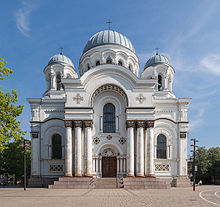Early history[edit]
According to the archeological excavations, the most affluent collections of ceramics and other artifacts found at the confluence of the Nemunas and the Neris rivers are from the second and first millennium BC. During that time people settled in some territories of the present Kaunas: the confluence of the two longest rivers of Lithuania area, Eiguliai, Lampėdžiai, Linkuva, Kaniūkai, Marvelė, Pajiesys, Romainiai, Petrašiūnai, Sargėnai, and Veršvai sites.[9]
Grand Duchy of Lithuania[edit]
A settlement had been established on the site of the current Kaunas old town at the confluence of two large rivers, at least by the 10th century AD. Kaunas is first mentioned in written sources in 1361 when brick Kaunas Castle was constructed. In 1362, the castle was captured and destroyed by the Teutonic Order. The commander of the Kaunas castle garrison Vaidotas with 36 men tried to break through, but was taken prisoner. It was one of the largest and important military victories of the Teutonic Knights in the 14th century against Lithuania.[10] The Kaunas castle was rebuilt at the beginning of the 15th century.[11]
In 1408, the town was granted Magdeburg Rights by Vytautas the Great and became a centre of Kaunas Powiat in Trakai Voivodeship in 1413.[12] Vytautas ceded Kaunas the right to own the scales used for weighing the goods brought to the city or packed on site, wax processing, and woolen cloth trimming facilities. The power of the self-governing Kaunas was shared by three interrelated major institutions: vaitas (the Mayor), the Magistrate (12 lay judges and 4burgomasters) and the so-called Benchers' Court (12 persons). Kaunas then began to gain prominence, since it was at an intersection of trade routes and a river port. In 1441 Kaunas joined the Hanseatic League, and Hansa merchant office Kontor was opened — the only one in theGrand Duchy of Lithuania.[13] By the 16th century, Kaunas also had a public school and a hospital and was one of the best-formed towns in the whole country.[14]
In 1665, the Russian army attacked the city several times, and in 1701 the city was occupied by the Swedish Army. The Black Death struck the area in 1657 and 1708, and fires destroyed parts of the city in 1731 and 1732.[15]
Russian Empire[edit]
After the final partition of the Polish–Lithuanian state in 1795, the city was taken over by the Russian Empire and became a part of Vilna Governorate. During the French invasion of Russia in 1812, the Grand Army of Napoleon passed through Kaunas twice, devastating the city both times.[14]
To prevent possible easy access through the city and protect the western borders of Russia theKovno Fortress was built, still visible throughout the town.[16]
Kovno Governorate, with a centre in Kovno (Kaunas), was formed in 1843. In 1862, a railway connecting the Russian Empire and Imperial Germany was built, making Kaunas a significant railway hub with one of the first railway tunnels in the Empire, completed in 1861. In 1898 the firstpower plant in Lithuania started operating.[17]
Prior to the Second World War, Kaunas, like many other cities in eastern Europe, had a significant Jewish population. According to theRussian census of 1897, Jews numbered 25,500, 35.3% of the total of 73,500. The population was also 25.8% Russian, 22.7% Polish, 6.6% Lithuanian.[18]







No comments:
Post a Comment